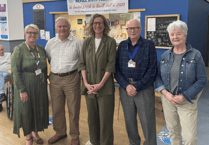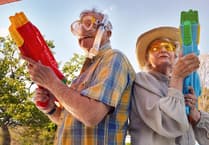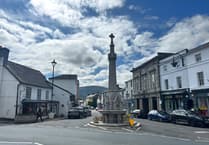Lying deep in a corner of Gilwern, nestled between the Heads of the Valleys road and the River Usk one might have thought they would encounter some local wildlife or an escape from the peace and quiet of everyday life.
Perhaps less expected would be a United States Military hospital, which has since been repurposed as a training centre for new HGV and bus drivers. But that is exactly what an army of volunteers and actors brought back to life for one weekend only at the end of August.
US troops were stationed in Gilwern during the Second World War, and it is almost 80 years to the day since they left the secluded western corner of Monmouthshire to assist with efforts on the continent after the conflict.
Richard Purkiss, a local historian and collector of military vehicles, has been researching the site for 20 years and remains fascinated by the site.
“A lot of people don’t know there was a hospital here,” he said.
“There were roughly 450 personnel here during the war and what we can see today is only 10 per cent of what existed 80 years ago. There were 26 buildings and only seven are left.”
“So we’ve done this to give locals an idea as to what’s on their doorstep and try to offer an authentic insight into what happened here 80 years ago.”
Of all the places in the world, the US army at the time chose Gilwern due to its proximity to the railway, in nearby Abergavenny, as well as close estates such as Llangattock and Glanusk among others, which were both American camps during the war.
The famous GI, Jimmy Cagney, would have made several appearances on the silver screen of The Coliseum, in Abergavenny. But he very nearly walked straight through it, as he too was stationed at Gilwern.
The local geography ticked every box for the Americans. The central belt of land across England and Wales, dubbed the ‘communication zone’, was crucial to training up soldiers before they made the trip south, and the site was also just far enough off the beaten track to hide from the enemy.
“If you had wounded soldiers coming back from Europe, you wouldn’t have wanted them all based on the south coast either,” Richard explained.
“You would move them inland along with all the reserve troops and supplies.”
The hospital was a specialist site for soldiers requiring skin grafts and amputations, which makes the transfer of them from Normandy, to the south coast and then via rail to Abergavenny, then by road to Gilwern, all the more impressive.
“It’s might be the only time we, as a group, will be bringing this site back to life as it was because it is a lot of work,” Richard said as one or two visitors recalled the American accents heard in the village during the war.
“It could be the last big anniversary where we will have a good number of people around who will remember these kinds of things as well, so this really is a special moment.”




Comments
This article has no comments yet. Be the first to leave a comment.